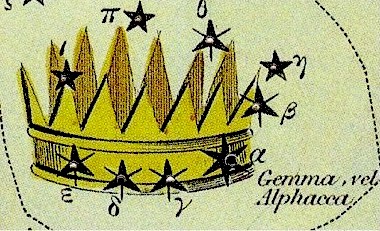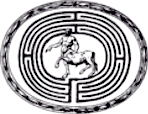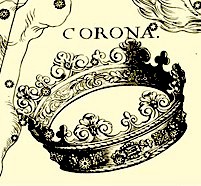Constellations of Words
Explore the etymology and symbolism of the constellations
the Northern Crown

Urania’s Mirror1825
Contents:
1. Clues to the meaning of this celestial feature
2. The fixed stars in this constellation
3. History_of_the_constellation
Clues to the meaning of this celestial feature
Corona Borealis, the Northern Crown, represents a crown given by Dionysus (Roman Bacchus, or Liber) to Ariadne, the daughter of Minos of Crete, who presented her with this Golden Crown inlaid with precious stones. It contains nine principal Stars, arranged in a semicircular form. [There is another crown in the heavens depicted in Corona Australis, the Southern Crown, it represents the crown given by Dionysus to his mother Semele].
 The story relating to Corona Borealis tells how Daedalus built a labyrinth, an elaborate maze-like construction, to house the Minotaur, a creature that was half man and half bull. Here it devoured the seven youths and seven maidens which were sent to it from Athens in tribute to king Minos of Crete who had conquered Athens. The tribute for the Minotaur was to be chosen by lot (sortis). When the third repetition of the nine-year tribute came around, Theseus inserted himself as one of the youths in the line-up. He got from Ariadne, daughter of Minos, who had fallen in love with him, the famous thread that enabled him to retrace his steps back through the Labyrinth. He slew the Minotaur, then, following the string or thread, he left the maze, unchained the young Athenians, and taking Ariadne whom he had promised to marry, along with him, they sailed off from Crete to Naxos. There Theseus deserted her as she lay sleeping. Ariadne was essentially marooned on an island, a castaway, while Theseus in his ship sailed off without her. Then Dionysus (Bacchus, Liber) came to her:
The story relating to Corona Borealis tells how Daedalus built a labyrinth, an elaborate maze-like construction, to house the Minotaur, a creature that was half man and half bull. Here it devoured the seven youths and seven maidens which were sent to it from Athens in tribute to king Minos of Crete who had conquered Athens. The tribute for the Minotaur was to be chosen by lot (sortis). When the third repetition of the nine-year tribute came around, Theseus inserted himself as one of the youths in the line-up. He got from Ariadne, daughter of Minos, who had fallen in love with him, the famous thread that enabled him to retrace his steps back through the Labyrinth. He slew the Minotaur, then, following the string or thread, he left the maze, unchained the young Athenians, and taking Ariadne whom he had promised to marry, along with him, they sailed off from Crete to Naxos. There Theseus deserted her as she lay sleeping. Ariadne was essentially marooned on an island, a castaway, while Theseus in his ship sailed off without her. Then Dionysus (Bacchus, Liber) came to her:
“Deserted and weeping bitterly, as she was, Bacchus-Liber brought her help and comfort. So that she might shine among the eternal stars, he took the crown from her forehead, and set it in the sky. It soared through the rarified air, and as it soared its jewels changed to bright fires, and took their place, retaining the appearance of a crown, as the Corona Borealis, between the kneeling Hercules and the head of the serpent (Serpens) that Ophiuchus holds” [Ovid, Metamorphoses, Bk VIII:152-182].

Ariadne as theconsortof Dionysos, late fourth century BCE, (Louvre). [
The myth of the Labyrinth can be read on this Theoi Projectwebpage. The myth of Ariadne on this Theoi Projectwebpage
Manilius’ astrological influences for this constellation (see under astrological influences below) gives the cultivation of gardens, growing flowers, and arranging flowers into garlands (flores sertisque locabit, from Latin serta, garland). [Some see Greek anthos, flower, in the suffix –inth of labyrinth, labrys is Minoan for ‘double-axe’. Labyrinth is a term for the inner ear]
Latin serta, ‘wreathes of flowers, garlands’, which Klein says “is properly plural neuter past participle of serere, ‘to join together’.” The pattern of the myth of ‘desertedAriadne‘ embraces a number of words from the Indo-European root *ser-. Latin serta, means a garland, from serere, to join. Crowns have a series of points, spikes (or they may be a turret shape). The tribute for the Minotaur was to be chosen by lot (sortilege, from sors, genitive sortis). These words come from the Indo-European root *ser- ‘To line up, lining up lots before drawing them’. Derivatives: series (cognate with Old Indian sarat, ‘thread’), assert, desert³ (abandon), dissertate, exert, exsert, insert, (these words from Latin serere, to arrange, attach, join – in speech, discuss), sermon, serried (in rows, from Latin sera, a lock, bolt, bar < ‘that which aligns’), assortment, sorcerer, sorcery, sort (means in this sense ‘destiny’ or ‘fortune’. Pronouncements from oracles were known as sortes in Latin, and sortes means ‘lots’ as in ‘casting lots’ or ‘drawing lots’), assort, consort, ensorcel (to enchant; bewitch), sortilege (the act or practice of foretelling the future by drawing lots). [Pokorny 4. ser– 911. Watkins] Klein and AHD adds desert (a barren desolate area).
“Our word disserit is used in a figurative meaning as well as in relation to the fields: for as the kitchen-gardener disserit ‘distributes’ the things of each kind upon his garden plots, so he who does the like in speaking is disertus ‘skilful.’ Sermo ‘conversation,’ I think, is from series ‘succession,’ whence serta ‘garlands’; and moreover in the case of a garment sartum ‘patched,’ because it is held together: for sermo ‘conversation’ cannot be where one man is alone, but where his speech is joined with another’s. So we are said consereremanum ‘to join hand-to-hand fight’ with an enemy; so to call for manumconsertum ‘a laying on of hands’ according to law; from this, adsereremanuinlibertatem’ to claim that so-and-so is free,’ when we lay hold of him. So the augurs say: If you authorize me to take in my hand the sacred bough, then name my colleagues (consortes). From this, moreover, sors ’lot,’ from which the consortes ‘colleagues’ themselves are named; from this, further, sortes ‘lots,’ because in them time-ideas are joined with men and things; from these, the sortilegi ‘lot-pickers, fortune-tellers’; from this, the money which is at interest is the sors ‘principal,’ because it joins one expense to another” [Varro: On The Latin Language, p.64, 66].
Ariadne, having married Dionysus, to be his consort. A consort crown is a crown worn by the Queen Consort of a kingdom for her coronation or on state occasions. Unlike with reigning monarchs, who may inherit one or more crowns for use, consorts sometimes had special crowns made uniquely for them and which were worn by no other later consort [].
Flora says: Bacchus [Dionysus] loves flowers. Bacchus’ pleasure in the wreath can be known from Ariadne’s star. Light theatre suits her. Do not, believe me, do not rank her with the tragic-booted goddesses [referring to the buskin boots worn by actors of Greek and Roman tragedies]. Indeed the reason why a crowd of whores packs these shows is not difficult to find. She is neither one of the glum set nor a snob; she wants her rites open to the plebs, and warns us to use life’s beauty as it blooms. [Ovid, Fasti 5.183
The Welsh knew the constellation, Corona Borealis, as CaerArianrhod, ‘castle of Arianhrod’, the prefix Arian– bearing a noted similarity to the name Ariadne. Caer ‘castle’ or ceaster, ‘castellated’ means turreted like a castle. Some crowns are described as turreted, Cybele wore a mural or turreted crown.
Romans poets associated the Minoan-Greek, Ariadne, with their goddess Libera []. Liber [Dionysos, or Bacchus] says to Ariadne:
“Let us seek heaven’s heights together. You have shared my bed and you will share my name. You will be named Libera, when transformed. I will create a monument of you and your crown, which Volcanus [Hephaistos] gave Venus [Aphrodite] and she gave you.’ He does what he said, and turns its nine gems to fires, and the golden crown glitters with nine stars.” – Ovid, Fasti 3.459 [
 The Statue of Liberty might relate to this constellation? Libera with a crown. The Statue of Liberty symbolically represents Libertas (liberty), Ancient Rome’s goddess of freedom from slavery, oppression and tyranny. Ariadne was marooned on an island. To be marooned is to be put ashore on a deserted island or coast and intentionally abandoned. A Maroon was the word for a fugitive slave in the West Indies in the 17th and 18th centuries. Liberia, a country in West Africa, was founded and settled mainly by freed slaves.
The Statue of Liberty might relate to this constellation? Libera with a crown. The Statue of Liberty symbolically represents Libertas (liberty), Ancient Rome’s goddess of freedom from slavery, oppression and tyranny. Ariadne was marooned on an island. To be marooned is to be put ashore on a deserted island or coast and intentionally abandoned. A Maroon was the word for a fugitive slave in the West Indies in the 17th and 18th centuries. Liberia, a country in West Africa, was founded and settled mainly by freed slaves.
The crown has associations with both liberty and also slavery “in ancient times slaves taken by right of conquest were sold wearing garlands, and hence were said to be sold ‘under a crown.’ For as the crown was a sign that those who were being sold were captives” [Aulus Gellius, (ca. 125 AD—after 180 AD), Noctes Atticae, Book 6]. The word ‘slave’ is related to the name of the adjacent constellation Hercules, who was a slave to Omphale for a year.
The crown given to Ariadne belonged to Venus: Allen (Star Names) says that when deserted by Theseus she became the wife of Liber Bacchus, and so took his name Libera; while the crown that Theseus — or, as some said, the goddess Venus — had given her was transferred to the sky:
“Victory herself is named from the fact that the overpowered vinciuntur ‘are bound.’ Poetry bears testimony to both, because both Victory and Venus are called heaven-born; for Tellus ‘Earth,’ because she was the first one bound to the Sky, is from that called Victory. Therefore she is connected with the corona ‘garland’ and the palma ‘palm’ [the customary symbols of victory] because the garland is a binder of the head and is itself, from vinctura’ binding,’ said vieri’ to be plaited,’ that is, vinciri ‘to be bound’; whence there is the line in Ennius’s Sota: The lustful pair were going, to plait the Love-god’s garland”. [Varro: On The Latin Language, p.59 ]
The astrological influences of the constellation given by Manilius:
“Corona the Crown’s lustrous ring, which twinkles with varying luminosity; for the circle is dominated by a single star [Alphecca], which with passing splendor sparkles in the mid forehead and enhances with its blazing flame the bright lights of the constellation. They shine as the memorial of deserted Ariadne” [Manilius, Astronomica, 1st century AD, book 5, p.29].
“Next to rise is Erigone [Virgo]. When you behold her ascending with five degrees wrested from the sea, there will emerge from the waves the bright memorial of what was once [in her lifetime] Ariadne’s crown; and gentle will be the skills herefrom bestowed. For here shines a maiden’s gifts. The child of the Crown will cultivate a garden budding with bright flowers and slopes. Grey with olive (trees) or green with grass. He will plant pale violets, purple hyacinths, lilies, poppies which vie with bright Tyrian dyes, and the rose which blooms with the redness of blood, and will stipple meadows with designs of natural color. Or he will entwine different flowers and arrange them in garlands; he will wreathe the constellation under which he was born, and like Ariadne’s crown will be the crowns he fashions; and stems he will squeeze together, and distil mixtures (make perfume) therefrom, and will flavor Arabian with Syrian scents and produce unguents which give off a mingled fragrance, that the charm of the perfume be enhanced by the blending. His heart is set upon elegance, fashion, and the art of adornment, upon gracious living and the pleasure of the hour. Such is the endowment prescribed by the years of the Maid and the flowers of the Crown” [Manilius, Astronomica, 1st century AD, book 5, p.321.]
© Anne Wright 2008.
| Fixed stars in Corona Borealis | |||||||
| Star | 1900 | 2000 | R A | Decl 1950 | Lat | Mag | Sp |
| Nusakan beta | 07SCO43 | 09SCO07 | 231 26 30 | +29 16 37 | +46 03 30 | 3.72 | A8 |
| theta | 08SCO04 | 09SCO27 | 232 43 40 | +31 31 36 | +48 33 24 | 4.17 | B5 |
| Alphecca alpha | 10SCO53 | 12SCO18 | 233 08 33 | +26 52 54 | +44 19 43 | 2.31 | A0 |
| gamma | 13SCO29 | 14SCO52 | 235 09 38 | +26 27 10 | +44 30 42 | 3.93 | A0 |
| delta | 15SCO39 | 17SCO02 | 236 52 26 | +26 13 12 | +44 46 14 | 4.73 | G4 |
| iota | 17SCO38 | 19SCO01 | 239 51 34 | +29 59 23 | +49 09 53 | 4.91 | A1 |
| epsilon | 17SCO44 | 19SCO07 | 238 52 44 | +27 01 17 | +46 04 30 | 4.22 | K2 |

Hevelius,Firmamentum, 1690
History of the constellation
from Star Names, 1889, Richard H. Allen
Looke! how the crowne which Ariadne wore
Upon her yvory forehead, . . .
Being now placed in the firmament,
Through the bright heavens doth her beams display,
And is unto the starres an ornament,
Which round about her move in order excellent.
— Spenser’s FaerieQueen
Corona Borealis, the Northern Crown {Page 174} is the French CouronneBoreale, the German NordlicheKrone, and the Italian ancestral Corona. It was the only stellar crown known to Eratosthenes and the early Greeks, but they called it Stephanos, a Wreath; and their successors, who had begun to locate the Southern Crown (Corona Australis), added to this title of the original the distinguishing protos; and beta Borelos to show its priority and its northern position. The Latins adopted the Greek name and adjectives in Coronaborea, borealis, and septentrionalis; and further knew it as theCrownofVulcan fashioned exauroetindicisgemmis; or of Amphitrite, probably from its proximity in the sky to the Dolphin (Delphinus) associated with that goddess. But generally it was AriadnaeaCorona, CoronaAriadnae, CoronaAriadnes, CressaCorona, CoronaGnosida, CoronaCretica and Gnossis, varied by MinoiaCorona and MinoiaVirgo found with Valerius Flaccus and Germanicus, and AriadnaeaSidus with Ovid; these classical designations referring to Ariadne, or to her father Minos, king of Crete, and to her birthplace in that island, at Gnosos, where Theseus married her. When deserted by him she became the wife of Liber Bacchus, and so took his name Libera; while the crown that Theseus — or, as some said, the goddess Venus — had given her was transferred to the sky, where it became our Corona; and, as early as the 3rd century B.C., Apollonius Rhodius wrote in his Argonauticae
Still her sign is seen in heaven,
And midst the glittering symbols of the sky
The starry crown of Ariadne glides.
Keats changed this in his Lamia to Ariadne’tiar; and others made it the CoiledHairofAriadne as companion to the Streaming Tresses of Berenice (Coma Berenices). Some authors, however, — Ovid among them in his Fasti— said that Ariadne herself became the constellation; and Mrs. Browning, in her Paraphrases from Nonnus of HowBacchuscomfortsAriadne
{Page 175} Or wilt thou choose
A still surpassing glory? — take it all —
A heavenly house, Kronion’s self for kin.
This legend of Ariadne and her Crown seems to have been first recorded by Pherecydes early in the 5th century before Christ.
Dante, referring to Ariadne’s descent, called these stars laFigliuoladiMinoi, the poet giving much prominence to her father (King Minos) who “was so renowned for justice as to be called the Favorite of the Gods, and after death made Supreme Judge in the Infernal Regions.”
In all ages Corona has been a favorite, popularly as well as in literature, and few of our stellar groups have had as many titles, although the English of the Middle Ages usually wrote its wearer’s name “Adrian” and “Adriane.”
Chaucer had this strange passage on the constellation:
And in the sygne of Taurus men may see
The stonys of hire coroune shyne clere;
but this seems unintelligible, unless from some confusion in the poet’s mind with the location of Koronis of the Hyades. These, however, lie in the heavens just opposite the Crown, and Skeat ingeniously suggests that Chaucer may have meant that when the Sun was in Taurus the Crown was specially noticeable in the midnight sky, as is exactly the case.
“England’s Arch Poet,” Edmund Spenser, wrote in the ShepheardKalendar of 1579:
And now the Sunne hath reared up his fierie footed teme,
Making his way between the Cuppe (Crater) and golden Diademe;
one of the early titles of Corona being DiademaCoeli
The WreathofFlowers, occasionally seen for it, is merely the early signification of the words Stephanos and Corona.
Oculus was another name of the constellation — a term common in poetry and post-Augustan prose for any celestial luminary; and Prudens [Aurelius Clemens Prudentius, the Latin Christian poet of our 4th century] called it Maera, the Shining One.
As the ardenscorona of the Georgics, Vergil included it with the Pleiades as a calendar sign. May translating the passage:
{Page 176} But if thou plow to sowe more solid graine,
A wheat or barley harvest to obtaine:
First let the morning Pleiades be set,
And Ariadne’s shining Coronet,
Ere thou commit thy seed to ground, and there
Dare trust the hope of all the following yeare.
Columella, in a similar connection, called it GnosiaArdorBacchi, and NaxiusArdor, from Naxos, where Ariadne had been deserted by Theseus; and specially designated its lucida as claraStella
Its stars were favored also by the astrologers, Manilius expressing this in:
Births influenced then shall raise fine Beds of Flowers,
And twine their creeping Jasmine round their Bowers;
The Lillies, Violets in Banks dispose,
The Purple Poppy, and the blushing Rose:
For Pleasure shades their rising Mounts shall yield,
And real Figures paint the gawdy Field;
Or they shall wreath their Flowers, their Sweets entwine,
To grace their Mistress, or to Crown their Wine.
Bayer said of it AzophiParma, by which he meant that Al Sufi called it a Shield; but the majority of Arabian astronomers rendered the classical title by AlIklilalShamaliyyah, which degenerated into Acliluschemali and Aclushemali, and appeared with Ulug Beg as plain Iklil
But in early Arabia there was a different figure here, AlFakkah, the Dish, which Ulug Beg’s translator gave as Phecca, and others as Alphaca, Alfecca, Alfacca, Foca, Alfeta, and Alfelta; while Riccioli said AlphenaSyrochaldaeis; and Schickard, Alphakhaco
Hyde quoted KasatalSalik, and KasatalMasakin, the Pauper’s Bowl; and the Persians had the same in their KasahDarwishan, the Dervish’s Platter, or KasahShekesteh, the Broken Platter, because the circle is incomplete. Bullialdus latinized some of these titles in his Discusparvusconfractus, evidently taken from Chrysococca’s Pinakin keklasmenon, a Small Broken Dish, which, however, should read Pinakion (A “pinax” or “pinakion”, meaning “tablet,” because of its flat shape.).
The AlfonsineTables have Malfelcarre, “of the Chaldaeans,” Riccioli’s Malphelcane, considered by Ideler a degenerate form of the Arabic AlMuniralFakkah, the Bright One of the Dish; though Buttmann derived it from AlMalfalKhatar, the Loop of the Wreath, or the Junction of the Crown; and Scaliger suggested AlMalifalKurra, of somewhat similar meaning, more correctly written AlMilaffalKurrah. Bayer said Malphelcarrequodestsertumpupillae, the Circle of the Pupil of the Eye; and, although he did not explain this, may have written better than he knew, {Page 177} for Pupilla is the Latin equivalent of Kore, which, as a proper name, was a title for Persephone. In La Lande’s Astronomic Dupuis (circe 1862) devoted much space to his identification of this goddess, the Latin Proserpina, with the Chaldaean Phersephon, taking the title from Phe’er, Crown, and Serphon, Northern. Thus, if Dupuis be correct, the origin of the figure, as well as of the name, may lie far back of Cretan days. The Hebrews are said to have called it ‘Ataroth, the Crown, — perhaps of the Semitic queen Cushiopeia; and the Syrians, Ashtaroth, their Astarte, the Aphrodite of the Greeks and the Venus of the Latins; but all this seems doubtful, as also is Ewald’s conjecture that it was the biblical Mazzaroth.
Blake quotes from Flammarion, Vichaca, but without explanation.
Reeves catalogued it as the Chinese KwanSoo, a Cord. In Celtic story Corona was CaerArianrod, the House of Arianrod or Ethlenn, the sister of Gwydyon and daughter of Don, the Fairy King, this name bearing a singular resemblance to that of the classical owner of the Crown.
The Shawnee Indians knew it as the CelestialSisters, the fairest of them being the wife of the hunter White Hawk, our Arcturus
Caesius said that it represented the CrownthatAhasuerusplaceduponEsther’head, or the goldenoneoftheAmmoniteKing of a talent’s weight, or the CrownofThorns worn by the Christ.
Tlie LeydenManuscript shows it as a laurel wreath, and thus, or as a typical crown, it appears on the maps. In the FirmamentumFirmianum, a work of 1731, in honor of the persecuting bishop of Salzburg, of the Firmian family, the figuring is that of the CoronaFirmiana, with a stag’s antlers from the coat of arms of that family. But an exception to the rule may be noted in an illustration, in the original AlfonsineTables, of a plain three-quarter circle, entirely unlike either crown or wreath. Proctor suggested that in the earliest astronomy it may have formed the right arm of Bootes
It is interesting to the astronomer from its many close binaries, and is a favorite object with youthful observers, who generally know it as Ariadne’Crown. It certainly is much more like that for which it is named than usually is the case with our sky figures; and it is equally suggestive to the Australian native of the Woomera, our Boomerang, his idea of Corona’s stars.
Here appeared very suddenly, 58′ south of epsilon, on the 12th of May, 1866, the celebrated BlazeStar as a 2d-magnitude visible to the naked eye for only eight days, declining, with some fluctuations, to the 10th magnitude at the rate of half a magnitude a day, but rising again to the 8th, where it {Page 178} still remains as T Coronae, a pale yellow, slightly variable star. Although called a nova, Argelander had already mapped it on the 18th of May, 1855, and again noted it on the 31st of March, 1856, probably at its normal magnitude. It was the first temporary star to be “studied by the universal chemical method” — the spectroscope.
Near its place the VariabilisCoronae, now lettered R, was discovered by Pigott in 1795, still varying from 5.8 to 13, but with much irregularity.
Professor Young repeats the bagdel of Cassiopeia as a help to the memory in locating the stars of this constellation. The extreme northern one is theta, but then follow in order beta, alpha, gamma, delta, epsilon, iota. They form an almost perfect semicircle 20° northeast of Arcturus
Argelander gives a total of 27 stars visible to the naked eye; and Heis, 31.
One plac’d i’ th’ front above the rest displays
A vigorous light, and darts surprising rays —
The Monument of the forsaken Maid.
— Creech’s Manilius
Star Names: Their Lore and Meaning, Richard H. Allen, 1889.]